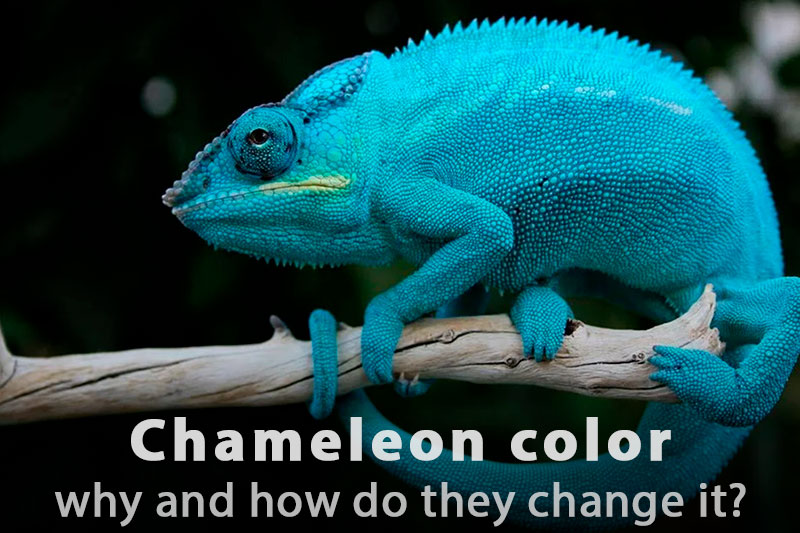Chameleon is an amazing, extraordinary creature. People often think that a chameleon changes its color to blend into its surroundings. But what do you say if this distinctive ability turns out to be just a myth? We will try to dispel a myth and find the truth while relying on proven facts.

The fact is, it's a chameleon's state and the environmental conditions that trigger the color-changing process.
Most of them are just computer-generated advertising gimmicks.
A chameleon has specialized cells called chromatophores that selectively reflect sunlight.
Chameleons are often found throughout Africa. You may also find them in Madagascar, Southern India, Arabian Peninsula, Turkey, as well as in Spain and Portugal. Chameleons range in size widely — some species grow from 3 to 60 centimeters (1.18—23.6 inches)! There are over two hundred different species of chameleons, but they all share the same feature – the ability to change skin color!
Ask anyone about a distinguishing trait of chameleons, and almost everyone will remember their color-changing ability. However, most people will refer to camouflage as a reason, and they will be wrong. Unfortunately, this myth has also been carefully cultivated by advertising companies, who seek to make a fortune from the reptile's well-known ability.
Scientists found long ago that color changing can indicate the change in a chameleon's "mood." This means high stress may well lead it to recolor. Sometimes males change their colors to attract females during mating season, which is typical for other animals, birds, etc. Male peacocks, for example, spread their gorgeous tail feathers to get females' attention.
Additionally, outside factors, such as temperature, humidity level, and others, can also affect the change of colors. A chameleon may darken its color to absorb more heat and quickly warm up while having a lighter color on hot days to reflect sunlight and avoid overheating effectively.
 It's all about chromatophores. These specialized cells allow chameleons (and other animals) to reflect the light of different wavelengths selectively. Chameleons have sacs filled with different kinds of pigment, including yellow, red, black, and dark brown. By contracting chromatophores' extensions, chameleons can reorder the sacs with pigments across the layers and choose the needed hue. Thus, when a dark pigment is concentrated in the upper layer of a chameleon's skin, it turns dark. Using pigments of two layers, the reptile can get a wide variety of shades. It's a time-consuming process and usually takes a few minutes. Chameleons are not able to "recolor" every second when walking around different items.
It's all about chromatophores. These specialized cells allow chameleons (and other animals) to reflect the light of different wavelengths selectively. Chameleons have sacs filled with different kinds of pigment, including yellow, red, black, and dark brown. By contracting chromatophores' extensions, chameleons can reorder the sacs with pigments across the layers and choose the needed hue. Thus, when a dark pigment is concentrated in the upper layer of a chameleon's skin, it turns dark. Using pigments of two layers, the reptile can get a wide variety of shades. It's a time-consuming process and usually takes a few minutes. Chameleons are not able to "recolor" every second when walking around different items.
Most of the time, chameleons stay green. Apparently, it is a protective hue, as a chameleon mainly lives among leaves or grass. The scientists explain its greenness by crystals of guanine within the upper layer of the skin. Thanks to that, sunlight gets refracted and makes a chameleon green.
Notably, different species feature sacs with different pigments in their skin, which is clear given their diverse habitats, including trees, rocks, and the surface, and therefore, their safety coloration varies.
Its color-changing ability results in a chameleon being primarily a diurnal animal. At night, they lose control over the color, and it gets pale, making a chameleon easy for predators to spot. Thus, chameleons hide in shelters like branches with dense foliage to sleep.
The above may be a huge surprise for some readers since the Internet is teeming with videos clearly showing how chameleons change their color almost in a blink of an eye, aligning them with their surroundings. This is nothing but computer graphics. Many corporations striving to promote their goods may use a range of tricks, including the most uncommon ones, "recoloring" is one of them.
The first thing to say about it is that chameleons never blink. On the other hand, they have fused eyelids with tiny opening slits to perfectly see everything around them. While typical humans can look only straight at a single point, the chameleon's eyes move independently and can see in different directions. Furthermore, the unique anatomy of chameleons' eyes enables panoramic vision so that no insect can get by unnoticed. Chameleons rely on slow movement to save energy and hide from predators. In contrast, their eyes move almost all the time. Once a chameleon spots its prey, it refocuses its eyes to understand if it is able to hook the target with its long, far-reaching tongue.
The chameleon's tongue, which is remarkably well adapted to catching even the nimblest and large insects, is a genuine crown of evolution. Firstly, a chameleon's tongue is not a simple muscle, as in most animals; a special lower jaw bone also empowers it.
A chameleon's tongue features a suction cup on its tip necessary for catching prey. Chameleons stick out their tongues so fast that only a trained eye can spot it – it takes 0.05 seconds for a chameleon to catch an insect! Returning the tongue back to its mouth is way slower, taking almost half a second. Even so, with plenty of insects around, a chameleon can catch up to four of them in just three seconds!
References: Links and sources